| Back Number | No.04 2004/12/08 | |||
| News | The Mammoth Arrives |  |
||
| Pavilions : NGO Global Village | ||||
| Interview | Vicente Gonzalez Loscertales Secretary-General of the International Exhibitions Bureau (BIE) |
|||
| Column | Enjoy the Gastronomic Fares of EXPO 2005 Aichi, Japan! | |||
![]()
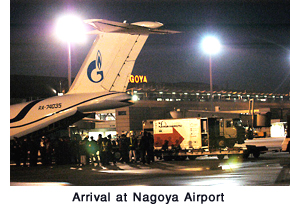 The remains of a Yukagir Mammoth, to be a centerpiece attraction at EXPO 2005 Aichi, Japan, arrived by charter plane in the early evening of November 19 at Nagoya Airport in Aichi Prefecture, the venue of EXPO 2005. It had been transported approximately 4,100 kilometers from the Republic of Sakha (Russian Federation) in a reefer container. This frozen cargo transporter containing the Yukagir Mammoth was transferred onto a truck and was safely delivered to the EXPO 2005 Nagakute Area in the same evening. It will be securely stored in the reefer container until the opening of EXPO 2005.
The remains of a Yukagir Mammoth, to be a centerpiece attraction at EXPO 2005 Aichi, Japan, arrived by charter plane in the early evening of November 19 at Nagoya Airport in Aichi Prefecture, the venue of EXPO 2005. It had been transported approximately 4,100 kilometers from the Republic of Sakha (Russian Federation) in a reefer container. This frozen cargo transporter containing the Yukagir Mammoth was transferred onto a truck and was safely delivered to the EXPO 2005 Nagakute Area in the same evening. It will be securely stored in the reefer container until the opening of EXPO 2005.The remains of the Yukagir Mammoth was discovered in permafrost on the southern bank of a river some 30 kilometers to the east of the village of Yukagir, located in the northernmost region of the Republic of Sakha. The excavation and scientific research has been conducted as joint international scientific research project. In addition to the head with two intact tusks, the excavated parts of the mammoth included several ribs, shoulder blades, a humerus, and a left front leg in which skin and muscle remain. The head not only has skin with hair still attached but also, on the left side, an eye socket with an eyelid as well as a completely intact ear. According to a dating technique through radiocarbons contained in the bones and fur, the specimen is estimated to have lived about 18,000 years ago. Judging from the size and curvature of the tusk, this mammoth was a mature male between the age of 40 and 45. Furthermore, through the total length of each part of the left front leg, etc., the estimated shoulder height is about 2.8 meters, and the weight of the mammoth was between four and five tons. |
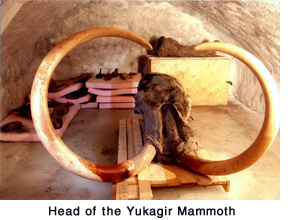 Naoki Suzuki (Professor, Jikei University School of Medicine), vice-chairman of the Scientific Council for Research on the Yukagir Mammoth said, at a press conference held on the day of the mammoth’s arrival in Japan, “This is an extremely well preserved mammoth. Considering the possibilities of the remaining soft tissues such as the brain, blood vessels and jaw muscles, we believe this specimen is a mine of information that we have wanted to acquire.”
Naoki Suzuki (Professor, Jikei University School of Medicine), vice-chairman of the Scientific Council for Research on the Yukagir Mammoth said, at a press conference held on the day of the mammoth’s arrival in Japan, “This is an extremely well preserved mammoth. Considering the possibilities of the remaining soft tissues such as the brain, blood vessels and jaw muscles, we believe this specimen is a mine of information that we have wanted to acquire.”Various studies and research of mammoth’s head utilizing cutting-edge technology, such as three-dimensional measurements through X-ray CT scanner, are planned to be conducted. A special pavilion with a freezing display room for the exhibition of the Yukagir Mammoth is currently being constructed by the Japan Association for the 2005 World Exposition adjacent to the Global House, the symbol pavilion of EXPO 2005. The temperature within the room will be maintained at about minus 15 degrees centigrade. This exhibition pavilion will also function as a research facility, and scientific research on this mammoth will continue to take place during EXPO 2005. A reconstructed model of the entire body of the Yukagir Mammoth, reconstructed based on scientific data, is also scheduled to be displayed within the Global House. A symposium focused on the Yukagir Mammoth was held in Yakutsk, Sakha Republic on November 17 and 18. About 100 participants gathered from Russia and Japan as well as the United States and Europe. Toshio Nakamura, Secretary-General of the Japan Association for the 2005 World Exposition said, at the press conference, “We think that the exhibit of the mammoth at this world exposition will be a great success if it has the impact of acting as a wake-up call by enhancing people’s awareness of the global issues facing humankind today. We want to do everything that we can to make it a success.” |
![]()
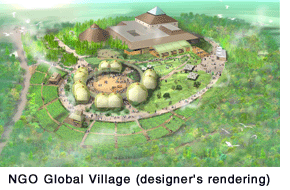 The NGO Global Village is one of the projects planned by the Japan Association for the 2005 World Exposition. Here, citizen's groups, such as nonprofit organizations (NPOs) and nongovernmental organizations (NGOs), will be
exhibiting at a world exposition for the first time. The NGO Global Village is one of the projects planned by the Japan Association for the 2005 World Exposition. Here, citizen's groups, such as nonprofit organizations (NPOs) and nongovernmental organizations (NGOs), will be
exhibiting at a world exposition for the first time.The objective of NGO Global Village is for it to become a place of learning and exchange for the resolution of the global issues faced by humankind in the 21st century. The concept of the Village is "Learning for Sustainability." As a basic rule, a Japanese NPO or NGO organization will participate in the NGO Global Village by forming a "unit" in which they host a partnership with domestic and overseas NPOs and NGOs. For example, an organization that supports citizen's afforestation activities in Japan will host and become a partner of a British citizen's organization that promotes the environmental protection of forests, countryside, etc., in the U.K. These organizations will thus form a "unit" and jointly unfold their exhibits as well as learning and exchange programs. Roughly 80 organizations that will form 30 units, focused around those who are involved in activities for sustainability through the fields of nature and the environment and international exchange and cooperation, have gathered from around the globe to participate in EXPO 2005. NGO Global Village will be situated in the northwestern part of the Nagakute Area on a small hill with a good view. It will be comprised of two areas: the Orientation Zone and the Experience and Exchange Zone. The Orientation Zone will consist of the Center House that will orient visitors on the significance and concept of the NGO Global Village by utilizing an existing facility to show theme exhibits as well as partnership booths with cooperating companies. Introductions of the NPOs and NGOs participating in EXPO 2005, as well as information on facilities and events, will also be provided here. The Earth Dreaming Theater within the Center House will be a large, dome shaped sky screen where visitors can lie on the floor and watch footage on the "Earth Dreaming" theme. The grandiose history of our planet that will begin with its birth and trace its 4.6 billion year history can be viewed here through symbolic imagery. |
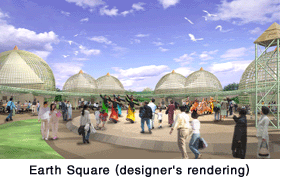 The Experience and Exchange Zone will consist of five pavilions and a
workshop hall that will surround a round multipurpose area called the
Earth Square. The pavilions and workshop hall are called the "Bamboo
Egg." It is an ecologically-friendly egg-shaped structure that utilizes
natural materials such as bamboo, wood, soil and fabric. It will blend
in well with the bamboo groves and tea plantations in its vicinity. The
NGO Global Village's main area will be comprised of these five pavilions.
The Experience and Exchange Zone will consist of five pavilions and a
workshop hall that will surround a round multipurpose area called the
Earth Square. The pavilions and workshop hall are called the "Bamboo
Egg." It is an ecologically-friendly egg-shaped structure that utilizes
natural materials such as bamboo, wood, soil and fabric. It will blend
in well with the bamboo groves and tea plantations in its vicinity. The
NGO Global Village's main area will be comprised of these five pavilions.Under the theme, "Learning for Sustainability," NPOs/NGOs will use one of the pavilions in rotation each month to unfold exhibits and events that leverages their experiences. A total of 30 units, or five units each month that will commence their exhibits, etc. at the beginning of the month, will participate. The theme is not restricted to environmental issues. It will also include various matters such as issues related to peace, poverty and human rights. For example, a unit will recreate a site that is boundlessly similar to a real refugee camp using actual tents, supplies and facilities, while also exhibiting photos or films of their activities. In the square at the center of the Zone, there will be various enticing events taking place, such as "full moon concerts" to be held when the moon is full, symposiums based on various themes and demonstrations of ethnic songs and dance. The NGO Global Village will probably become a wonderful opportunity for you to think about what you can do for a sustainable global environment. |
![]()
![]()
 |
|
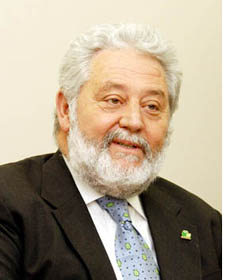 The theme of EXPO 2005 Aichi, Japan, “Nature’s Wisdom,” is very well expressed in the overall design of the venue. I think that the organizers of EXPO 2005 faced a very difficult challenge: how to create an agreeable setting for visitors while protecting the natural environment at the same time? They have overcome this challenge brilliantly.
The theme of EXPO 2005 Aichi, Japan, “Nature’s Wisdom,” is very well expressed in the overall design of the venue. I think that the organizers of EXPO 2005 faced a very difficult challenge: how to create an agreeable setting for visitors while protecting the natural environment at the same time? They have overcome this challenge brilliantly.This is an Expo that could only be held in Japan. Japan is one of the most industrialized countries in the world, but at the same time, it has a sense of nature and a sense of beauty. The people of Japan observe traditions in their daily lives and live in a rich culture. They also know the limits of industrialization as well as the importance of culture and simple and refined life. I think that all of these things are present here in EXPO 2005 Aichi, Japan. Not only governments but also civil society and industries all play leading roles in the Expos of the 21st century. Expos are a way to show the visions of citizens’ future prosperity. The citizens of the 21st century need international cooperation and dialogue. They also need respect for each other’s cultures and the awareness that cultural diversity is the wealth of humankind. I think that as the first Expo of the 21st century, EXPO 2005 Aichi, Japan will be an opportunity to widely enlighten citizens about the need of these values. I would like the citizens of Japan and the world to visit EXPO 2005 Aichi, Japan and enjoy this EXPO. Do not look at the EXPO like a visit to a museum. Be active, meet and speak with friends of the world. I think that if you enjoy the EXPO in this way, your visit will become the best experience of your lifetime. |
|
![]()
![]()
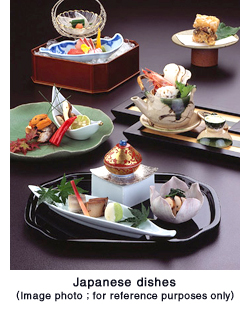 The delight of enjoying meals during a visit to a world exposition is
that you can try dishes from around the globe. What's more, you can savor
them in a multiplicity of ways.
The delight of enjoying meals during a visit to a world exposition is
that you can try dishes from around the globe. What's more, you can savor
them in a multiplicity of ways. First off, there will be many restaurants at EXPO 2005 Aichi, Japan recommendable for those who want to take their time relishing the authentic cuisines of various countries. At Nadaman, a genuine Japanese restaurant with a history of over 170 years, visitors will be able to experience dishes which make the most of ingredients and offer an experience that is expressive of the traditional Japanese culinary culture. Coming to the EXPO from Seto City, Aichi Prefecture, the venue of the EXPO, will be sushi bar Kaku, where visitors can conveniently experience the contemporary Japanese food culture by choosing a favorite sushi dish that passes before them on a revolving conveyer belt. There will also be Queen Alice Aqua, a casual French restaurant that will be based on tradition while using locally produced ingredients. Here, visitors will be able to enjoy healthy dishes. Another recommendation is Toh-Ka-Lin, an authentic Chinese restaurant, which will make full use of the wealth of cooking methods that have been cultivated over a history of 4,000 years. There are also restaurants recommendable for those who want to enjoy a fun meal in a festive environment. At KOREAN RESTAURANT KANICHITEI all kinds of kitchen utensils such as kitchen knives, pots and cutting boards will turn into percussion instruments that will pound out rhythms unfolding a musical "Nanta" performance for your enjoyment. For those who like beer, how about a German-style buffet at Restaurant Beer-Hall? Guests will be able to drink, dance and sing while listening to alphorn and cowbell performances as well as polkas and marches at the restaurant that will recreate the gaiety of the Oktoberfest beer festival. There will also be other enjoyable restaurants from around the world gathering at the EXPO, including Sofra that will offer Turkish court cuisine accompanied by enthralling belly dance. |
|
 Furthermore, the taste of the dishes at the authentic restaurants in the
pavilions of various countries should be exquisite. There, visitors will
be able to relish the respective unique cuisines while enveloped in the
atmosphere of the country.
Furthermore, the taste of the dishes at the authentic restaurants in the
pavilions of various countries should be exquisite. There, visitors will
be able to relish the respective unique cuisines while enveloped in the
atmosphere of the country. For those who want to enjoy the tastes of various countries at once, we recommend the three food courts: Festival FOOD COURT, PIEROTH'S WORLD FOOD & WINE COURT and World Restaurant. At these convenient restaurants, you will be able to select and eat as many dishes from around the world as you want. There will also be 10 other buffet-style restaurants and family restaurants at the EXPO, including those where visitors will be able to sample local dishes from Aichi Prefecture. 17 fast food restaurants should be useful for those who want to spare time eating in order to visit as many pavilions as they can. Visitors will be able to sit at one of the benches on the Global Loop elevated corridor to eat take-out dishes while enjoying the breeze that flows through the natural environment and looking at the vista of the venue that spreads below. There will also be a café operated by those centering on the students of Japan’s University of Tokyo. It will offer hotdogs, hamburgers, etc. The students are busy making preparations to create an artistic environment for the café Why not come to EXPO 2005 and enjoy tastes of the world exposition's food offerings? |
|
![]()
| EXPO 2005 AICHI, JAPAN Newsletter | |
| To read past issues:Back Number | |
| Editor/Publisher: Japan Association for
the 2005 World Exposition Head Office: 1533-1 Ibaragabasama, Nagakute-cho Aichi 480-1101 Japan Nagoya Office: Nagoya Daiya II Bldg 4F, 3-15-1 Meieki Nakamura-ku, Nagoya, Aichi 450-0002 Japan Tokyo Office: Iino Bldg 8F, 2-1-1 Uchisaiwai-cho Chiyoda-ku, Tokyo 100-0011 Japan |
 |
© Japan Association for the 2005 World Exposition
